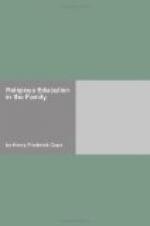But frequently the mother is a misleading teacher. To her the child goes with all the big questions outside the immediate world of things. Is she prepared to answer the questions? Few dilemmas of our life today are more pathetic than this: the mother has outgrown the theology of her childhood; she remembers keenly the suffering and superstition, the struggle that followed the darkened pictures she received as a little one, but she has nothing better to offer the child. No one has taught her how to put the later, more spiritual concepts into language for the child of our day. Weakly she falls back on the forms of words she once abhorred.
There are certainly two approaches of reality for the child-mind to the idea of God. Two immediate experiences are rich in meaning; they are the life of the family and the wonder of the everyday world, the life and variety of nature and human activities. The first is a very simple and rich approach. By every possible means help children in the family to think of God as the great and good Father of us all. Do this in the phrasing of prayers and graces, in the answers to their questions, in the casual word. Why should we assume that the Fatherhood of God is for the adult alone? And why should it be that this rich concept dawns on us like a new day of freedom in truth in later years instead of becoming ours in childhood and so determining the habit and attitude of our lives? The finest, the ideal person is, to the child, the father. God in terms of fatherhood is the sum and source of all that is ideal in personality.
The child’s keen interest in the world of nature is our opportunity to lead him to love the gracious source of all beauty and goodness. How keen is the child’s enjoyment of the beauty of the world! Can we forever fix the general concept of all this beauty as the thought of God in the words of flower and leaf, mountain and stream? And might we not also connect the idea of God with the affairs of daily life? That depends on the parent’s attitude of mind; if we think of the universal life that is behind all battles and business and affairs, there will be a difference in our answers to the thousand curious inquiries that rise in the child’s mind.
Nor must we leave the child to think of God as a separate, far-off person, on a throne somewhere in the skies. The child is finding his way into a universe. The God who is a minute fraction of that universe makes possible the religion that is no more than a negligible fraction of life. The child asks concerning clouds, the sea, the trees, the birds, and all the world about him; he tends to interpret it causally and ideally. Childhood affords the great opportunity for giving the color, the beauty and glory, the life of the divine to all this universe, to instil the feeling that God is everywhere, in all and through all, and that in him we live and move and have our being. The child’s joy in this world can thus be given a religious meaning. He sings




